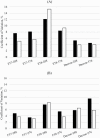Comparison of in situ techniques to evaluate the recovery of indigestible components and the accuracy of digestibility estimates
- PMID: 33031504
- PMCID: PMC7751196
- DOI: 10.1093/jas/skaa296
Comparison of in situ techniques to evaluate the recovery of indigestible components and the accuracy of digestibility estimates
Abstract
Indigestible components, including indigestible dry matter (iDM) and indigestible neutral detergent fiber (iNDF), play an integral role as internal markers for determining ruminal kinetics and digestibility estimations. However, the accuracy of internal markers is dependent upon the incubation technique utilized as bag type (BT) and incubation length (IL) can be significant sources of error. Previous studies have primarily focused on iDM and iNDF as digestibility markers, but few studies have compared digestibility estimates to those of acid detergent insoluble ash (ADIA). Therefore, our objective was to investigate the effect of BT (F57, F58, and Dacron) and IL (288 and 576 h) on iDM and iNDF residues, DM and NDF digestibilities, and fecal recoveries when using in situ incubations. Additionally, we evaluated the accuracy of digestibility estimates when using iDM, iNDF, and ADIA. For iDM and iNDF, feed residues demonstrated a BT × IL interaction (P < 0.01). However, fecal residues were only influenced by the main effects of BT and IL (P < 0.01), with the F58 BT and 288-h IL having the greatest residues for both iDM and iNDF. The variation in residues was greatly reduced when using iNDF compared with iDM. Fecal recovery estimates most closely approximated 100% recovery when utilizing ADIA and iDM using the F57 × 576 h incubation method (P < 0.01), although recovery was overestimated for all incubation combinations. Fecal NDF recovery estimates better represented the excretion profiles when the F57 × 576 h combination was used with iDM as the internal marker (P < 0.01). Estimates of DM and NDF digestibility were the most accurate when utilizing ADIA (P < 0.01) relative to all other treatments. Our results indicate that the proper methodological application is specific to the purpose of the inferences. When evaluating fecal recoveries and digestibility, ADIA or iDM with F57 at 576-h in situ incubation provides the greatest accuracy.
Keywords: acid detergent insoluble ash; indigestible DM; indigestible NDF; internal markers.
© The Author(s) 2020. Published by Oxford University Press on behalf of the American Society of Animal Science. All rights reserved. For permissions, please e-mail: journals.permissions@oup.com.
Figures
References
-
- AOAC 2000. Official methods of analysis. 17th ed. Association of Official Analytical Chemists. Arlington, VA.
-
- Detmann E, Paulino M F, Zervoudakis J T, Valadares Filho S de C, Euclydes R F, Lana R de P, and de Queiroz D S. . 2001. Cromo e indicadores internos na determinação do consumo de novilhos mestiços, suplementados, a pasto. Rev. Bras. Zootech. 30:1600–1609. doi:10.1590/S1516-35982001000600030 - DOI
-
- Dewhurst R J, Hepper D, and Webster A J F. . 1995. Comparison of in sacco and in vitro techniques for estimating the rate and extent of rumen fermentation of a range of dietary ingredients. Anim. Feed Sci. Technol. 51:211–229. 10.1016/0377-8401(94)00692-3 - DOI
-
- Goering H K, and Van Soest P J. . 1970. Forage fiber analysis. Handbook number 379. Washington (DC): Superintendent of Documents, US Government Printing Office.
-
- Harper K J, and McNeill D M. . 2015. The role of iNDF in the regulation of feed intake and the importance of its assessment in subtropical ruminant systems (the role of iNDF in the regulation of forage intake). Agriculture. 5:778–790. doi:10.3390/agriculture5030778 - DOI
Publication types
MeSH terms
Substances
LinkOut - more resources
Full Text Sources
Medical
Research Materials
Miscellaneous


